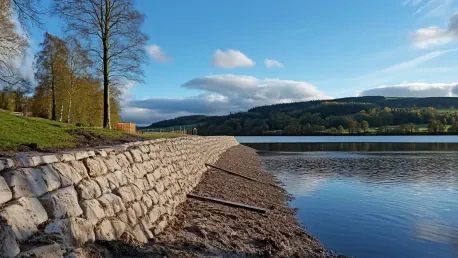Comrie, a picturesque village in Scotland, has long battled the threat of flooding due to its location at the confluence of three rivers: Earn, Lednock, and the Water of Ruchill. This article delves into the comprehensive flood defense scheme designed to shield Comrie from future flood events, highlighting the project’s planning, innovative engineering solutions, community involvement, and environmental considerations.
Historical Context
The Persistent Flood Risk
Comrie’s vulnerability to flooding is well-documented, with significant flood events recorded as far back as 1920. The village’s geographical location, situated at the meeting point of three rivers, makes it particularly susceptible to the overflow of these waterways. Over the decades, the rivers Earn, Lednock, and Water of Ruchill have repeatedly risen beyond their banks, causing significant disruption and damage. The unique and picturesque setting of Comrie, while charming, also places it in a precarious position when weather conditions lead to excessive rainfall.
This persistent flood risk has not only affected the infrastructure and property within the village but also posed a significant threat to the safety and well-being of its residents. The area’s historical susceptibility to flooding underscored the urgent need for a comprehensive and effective flood defense system. Without such measures, the village remained continually at risk, and economic development was impaired as the recurrent threat of flooding would dissuade investment and impact residents’ quality of life.
Notable Flood Events
The village of Comrie has experienced several devastating floods that have caused extensive damage and upheaval for its residents. Notably, significant flood incidents occurred in January 1993, February 1997, December 2006, and twice in 2012. Each of these events underscored the necessity for an effective long-term flood management strategy as they brought property damage, infrastructure loss, and disruptions to everyday life. The floods in 2012 were particularly catastrophic, affecting approximately 150 properties. This double occurrence of flooding within a single year prompted a greater call for action.
The repeated nature of these flood events highlighted the vulnerability of the village and its existing flood defenses. Post these events, the community experienced significant economic losses, displacement, and emotional distress. Local government and residents recognized the undeniable importance of developing a more robust and resilient flood defense system. These historical events provided vital lessons and data that informed the design and implementation of the new flood defense scheme, serving as a stark reminder of the consequences of inadequate flood protection measures.
Previous and Current Measures
Initial Flood Defense Efforts
Prior to the implementation of the new comprehensive flood defense scheme, Comrie’s flood defense efforts were concentrated primarily on the Water of Ruchill, especially in the Dalginross area. This focus addressed only part of the overarching flood risk since it did not consider the contributions of the other two rivers, Earn and Lednock. Following the destructive floods of 2012, the response included the addition of embankments and rock armor protections. These interim measures provided some level of reassurance for residents in the immediate aftermath.
However, while these initial efforts were steps in the right direction, they proved insufficient when considering the flood risks posed by all three rivers. The fragmented approach left other areas of the village vulnerable, illustrating that a piecemeal solution would not adequately mitigate the overarching flood risks faced by Comrie. The local residents and authorities came to the realization that only a comprehensive scheme addressing all the contributing factors would ensure lasting protection against future flooding.
Comprehensive Flood Defense Scheme
A significant turning point in the development of Comrie’s flood defenses occurred with the feasibility study carried out by Mouchel Consulting in 2017. This study highlighted the need for a more extensive flood protection plan, capable of addressing the unique geographical challenges posed by the convergence of the three rivers. Following this, Sweco was appointed to outline and design the broader flood defense scheme. This marked the beginning of a dedicated effort to create a systemic and cohesive flood mitigation strategy.
The process gained momentum with the submission of a formal flood order in February 2020, soon followed by the granting of planning permission in December 2021. This comprehensive plan represents a collaborative effort led by local authorities with the support of the Scottish government to ensure that Comrie receives the protection it desperately needs. The design phase was meticulously completed in May 2023, ensuring that the proposed measures would meet the specific needs of the village while also being sustainable and minimally intrusive.
Innovative Engineering Solutions
Design and Funding
Central to the comprehensive flood defense scheme is a project budget of £26.8M, which is primarily funded by the Scottish government along with significant contributions from the Perth and Kinross Council. This funding allocation is crucial for securing the necessary resources to protect 189 homes and businesses from a catastrophic 1-in-200-year flood event. The scheme incorporates a combination of structural defenses, including 2 km of flood walls and 0.9 km of embankments along the riverbanks of Earn, Lednock, and the Water of Ruchill.
These fortifications are designed to work in tandem to ensure maximum resilience and protection against flooding. Furthermore, the emphasis on using embankments reflects a commitment to sustainability and minimal visual impact, particularly within the designated Conservation Area of Comrie. Steel sheet pile flood walls were strategically chosen for their early protective capabilities and to minimize the bund cross-sectional area, drawing on the tried and tested methods from the Almondbank Flood Protection Scheme. This innovative selection was informed by Balfour Beatty’s prior experience, ensuring that the new measures were both effective and practical.
Sustainable and Minimal Impact Solutions
The decision to prioritize embankments over other types of flood defenses speaks to the project’s commitment to sustainability and the preservation of Comrie’s natural beauty and heritage. Embankments provide a less intrusive method of flood control, blending more harmoniously with the landscape compared to more imposing structural alternatives. This choice was instrumental in maintaining the village’s aesthetic, particularly within its Conservation Area, while offering robust flood protection.
Additionally, the implementation of steel sheet pile flood walls offers significant advantages. These structures ensure early flood protection and reduce the necessary bund cross-sectional area, offering both functional and logistical benefits. Such innovation minimizes the need for large-scale excavations and extensive modifications to the landscape, which can be disruptive both environmentally and to the daily life of the community. Moreover, by reducing embankment height through efficient design, the scheme endeavors to balance practical flood defense with ecological sensitivity, maintaining the natural integrity of the riverbanks.
Community and Environmental Considerations
Community Engagement
An integral component of the flood defense scheme is ongoing community involvement. The project team has prioritized keeping the residents of Comrie informed and engaged throughout the planning and construction phases. Such engagement includes organizing open days and regular updates to address any concerns, particularly regarding potential disruptions caused by construction activities. Given the proximity of construction sites to residential areas, special measures were taken to control and mitigate noise and vibrations, which were significant concerns for the community.
The project has been characterized by transparent communication and collaborative discussions, ensuring residents feel included and heard throughout the process. This approach not only helps in managing expectations but also fosters a sense of shared responsibility and community ownership over the flood defense measures. By involving the community, the project not only aims to protect the village physically but also to enhance the overall resilience and cohesion of its residents in the face of future environmental challenges.
Environmental Stewardship
Ensuring environmental stewardship has been a critical aspect of the flood defense scheme. Numerous environmental mitigations were put in place to minimize the impact on local wildlife and ecosystems. For example, artificial bat boxes and an otter holt were introduced to replace lost habitats, ensuring that the local fauna were not adversely affected by construction activities. Attention was also given to work timings to prevent disruptions to sensitive periods such as fish breeding seasons, further reflecting the commitment to environmental sustainability.
One of the innovative solutions employed in the project is the use of rootwad revetments. This method involves using tree trunks with their roots to stabilize the riverbank, which provides both ecological benefits and structural integrity. Rootwad revetments help reduce erosion, promote vegetation growth, and enhance the habitat for aquatic and terrestrial species. These measures contribute to a balanced approach, ensuring the flood defense infrastructure not only meets human needs but also aligns with and supports the local natural environment.
Construction and Future Outlook
Enabling Works and Challenges
The preliminary phase of the construction involved several enabling works, such as utilities diversions, archaeological trenching, and test pile drives. These preparatory tasks were critical in ensuring that the construction of the main flood defense structures could proceed smoothly and without unexpected delays. However, the installation of sheet piles near residential areas was not without its challenges. Noise and vibrations were significant concerns for the local residents, prompting the project team to adopt careful planning and mitigation measures.
To address these concerns, the team implemented noise reduction strategies and scheduling adjustments to minimize disruptions during sensitive times of the day. Furthermore, regular community updates and engagement ensured that residents were kept informed about the construction progress and any potential disturbances. This proactive approach helped maintain goodwill and cooperation between the construction team and the community, ultimately contributing to the smooth progression of the project.
Project Timeline and Completion
Comrie, a charming village nestled in Scotland, has faced a persistent challenge of flooding for years due to its strategic location where the three rivers—Earn, Lednock, and the Water of Ruchill—converge. This article delves into the extensive flood defense program meticulously designed to protect Comrie from potential flood disasters in the future. Highlighting the detailed planning process, the project showcases innovative engineering solutions, active participation from the local community, and thoughtful environmental considerations.
The scheme includes elevated embankments, improved drainage systems, and state-of-the-art flood barriers. Engineers worked closely with ecologists to ensure that the solutions minimized impacts on local wildlife and ecosystems. Residents were actively involved in the planning stages, attending meetings and providing valuable input to ensure the flood defenses met the community’s needs without compromising the village’s natural beauty.
Overall, this comprehensive approach aims not only to safeguard the village but also to create a sustainable environment. The article emphasizes the importance of community involvement and innovative engineering in addressing climate-related challenges, such as flooding. Through collaboration and advanced engineering, Comrie hopes to secure a safer future and maintain its picturesque charm despite the ongoing threat of flooding.









